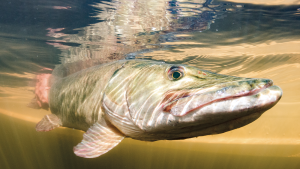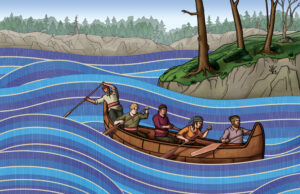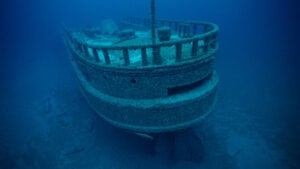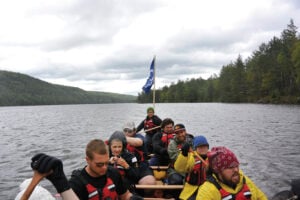
Environment
Space invasion: Is it too late to save the Great Lakes?
How a cocktail of invasive species and global change is altering the Great Lakes-St. Lawrence River ecosystem
- 2231 words
- 9 minutes
This article is over 5 years old and may contain outdated information.
Science & Tech

Watch Algoma Central Corporation’s bulk carrier G3 Marquis easing herself into Montreal’s St. Lambert Lock, and you quickly come to the conclusion that Great Lakes navigation must largely be a case of a captain’s ability to squeeze a very big object into a very small space. G3 Marquis is 226 metres long — roughly the same size as Toronto’s TD Bank Tower laid on its side. The St. Lambert Lock, like all locks in the St. Lawrence Seaway, is 233.5 metres long. That’s tight enough, but factor in the ship’s maximum beam and the lock’s maximum width, and it leaves about 30 centimetres of clearance on either side. As the ship’s fat bow slowly edges into the lock, pushing a mass of water in front of her, it’s easy to imagine everyone on board sucking in their stomachs to make enough room.
Laden with 30,000 tonnes of iron ore taken on in Port Cartier, Que., G3 Marquis is one of a new generation of freighters on Canada’s Great Lakes fleet. Before the likes of G3 Marquis, plenty of crews for Algoma Central and its major rival, Canada Steamship Lines, sailed in ships older than they were. But in 2010, the Canadian government removed a 25 per cent tariff on foreign-built ships, and both companies embarked on ambitious programs using yards in China and, later, Croatia. CSL began bringing its Trillium class into service. Algoma Central announced its Equinox class, which included G3 Marquis. These new lakers are built to the absolute maximum size the seaway allows and are faster, less polluting and require smaller crews than their predecessors.
The common name for these ships, bulk carriers, sums up the kinds of cargoes they carry — iron ore pellets, wheat, soybeans, gravel, cement, even road salt. These ships can carry these bulky commodities, still key products of Canada’s economy, more cheaply and efficiently in terms of energy use than any other means of transportation. In 2010, Canadian-flagged freighters carried more than 142 million tonnes of cargo on the lakes; about 48,000 jobs depend on them directly. The business was worth more than $16 billion that year. But sailing as they do far out on the lakes, we don’t often see them. It leaves one to wonder: What’s life like aboard these fast-paced freighters, where the world shrinks to the size of a ship?

Montreal’s St. Lambert Lock, on the south shore of the St. Lawrence, is a common spot for crew changeovers, close to the city and the airport. Many of Algoma’s crewmembers follow the established Great Lakes pattern of two months on board and one month off during a shipping season that runs roughly nine months. On this warm August evening, five of the crew are waiting to board G3 Marquis, including captain Mike Jolliffe and chief officer Rolly Abaigar. As the ship rises in the lock, a narrow aluminum walkway with handrails is dropped to lock side with a clatter — half a dozen crew members carrying suitcases scramble off, and the fresh crew scramble on. It’s like getting on and off a commuter train at rush hour. A minute or two later, as the ship continues to rise, the gangway is hauled in. The fresh crew members race to drop off their luggage. There’s no time for settling in. In a few minutes, the lock doors will open and G3 Marquis will be on her way to Chicago. (Just two days earlier, the ship had been slated to go to Thunder Bay; however, as Peter Winkley, Algoma’s chief financial officer, notes, a ship isn’t like a bus, showing up on a precise schedule with a given destination.)
Five decks up on the bridge, faint red lights illuminate the computer screens that show the ship’s course and monitor different systems — everything from engine to bilge pumps. There is a constant radio crackling, a stream of comments and requests from the seaway staff and other ships, to which Les Comrie — the skipper Mike Jolliffe will be relieving — constantly replies. Off to the north, Montreal is beginning to light up. By the next afternoon, the ship has cleared the last of the seven locks on the St. Lawrence River and is making its way through Ontario’s Thousand Islands toward Hamilton, threading past small rocky islands and improbable castles built by Gilded Age millionaires. Small power boats are constantly racing by the ship, often coming nerverackingly close, perhaps forgetting that G3 Marquis is nowhere near as nimble as they are. Before dark, the river widens out into the broad expanse of Lake Ontario. G3 Marquis ties up early the next morning alongside the Dofasco steel company dock in Hamilton, where its cargo from Quebec will be added to the sloping drumlin of purplish iron ore pellets, each about the size of a Skittle, running the length of the dock.

Because G3 Marquis will be here until well past nightfall, Victor Gordynskii, the chief engineer, wants to take advantage of time at dock to replace the piston ring on the number two cylinder, which sensors in the control room show has been running hot. Maintenance on a ship is a non-stop affair, but when the shipping season is in full swing, there aren’t many chances to carry out more thorough repairs.
While one engineer climbs into the crankcase to help replace the piston ring (with three other engineers on two separate decks positioning the three-metre-long rod), far above the engine room two enormous gantries are dipping their clamshell buckets into G3 Marquis’ open holds. Pellets dribble from the buckets as they rise and zip inland to dump their load on the dock.
Loading continues into the night — at one point, one of the gantries lowers a front-end loader into the holds, and a crew of sweepers climb down to gather every last possible bit of ore with brooms. As it gets darker, the ship’s surroundings take on a grimly ominous appearance: on the shore across the slip from where G3 Marquis is tied up, glowing molten metal dribbles down the side of a slag pile; on the other side of the iron pellets, fire spouts from the Dofasco mill’s dark chimneys, lighting up clouds of white smoke. “Mordor,” someone says, evoking the hellish blackened wastelands of J.R.R. Tolkien’s Middle-earth. Quite a contrast to the bucolic Thousand Islands.
Two days later, Detroit’s affluent suburbs lie off the ship’s port side as she crosses Lake St. Clair. Third mate Ayla Berry presses the button for the horn — one long and two short blasts, the standard short courtesy salute. Coming toward G3 Marquis is Baie St. Paul, a modern self-unloader belonging to CSL. Berry steps onto the walkway that surrounds the bridge and waves. A figure standing on the walkway of Baie St. Paul’s bridge waves back. It’s her husband, Jason, a deck officer. They met while at school at Georgian College in Owen Sound, Ont. In the offseason, they live on a 12-metre sailboat moored on Lake Ontario in Whitby.

Growing up on the shores of Georgian Bay, Berry had been interested in boats and the water for as long as she can remember. She sailed, she was a sea cadet, and after contemplating joining the coast guard, she went to school to become a deck officer. She’s not the only female deck officer on the lakes, but women in this line of work remain uncommon. The crew, she says, are “like a bunch of uncles.”

The G3 Marquis approaches Hamilton Harbour. (Photo: Thomas Fricke/Canadian Geographic)
The crew hail from a variety of hometowns across Ontario, Quebec and the Atlantic provinces, with some originally from farther afield — Ukraine, Philippines and Barbados. Five come from Newfoundland, two of them from the village of Burnt Islands. From a population of about 600, nearly half of the men from Burnt Islands are working the Great Lakes, says islander Calvin Chaulk.
What do these diverse crew members have in common? Often it’s a strong connection with the water. Like Berry, Captain Les Comrie sailed from childhood, in his case on Lake Ontario’s Bay of Quinte. Many of the guys from the Atlantic provinces are the sons and grandsons of sailors. One of the Burnt Islanders, ordinary seaman Art Seymour, was even born on a boat. Jolliffe, the captain, was in the naval reserve. Even before he first visited Georgian College’s marine studies program with the reserves, he had decided to make lake boats his career. “I’ve never looked back,” he says.
They are away a lot, six or seven months a year, but with email, Skype and cellphones, the isolation isn’t as bad as it once was. Jolliffe still remembers the days when, once a ship had tied up, “You’d have a long lineup standing in front of a pay phone in the rain yelling at the guy ahead to hurry up.” Unlike going to work in Fort McMurray, Alta., say, there’s no need to relocate to work on the Lakes. The company flies you to and from anywhere in Canada. (The pay is good too — junior crew can make around $60,000 a season, a captain more than $150,000.)
And yet, life on board still feels very separate from life on shore. This is particularly true at night, especially on a long run, such as north on Lake Huron after leaving the relatively tight confines of the St. Clair River. Around midnight, there might be three people awake on board — two on the bridge, one other several decks down in the engine control room. The auto-pilot is on. The wheelsman and the officer on watch pace slowly back and forth, looking out into the darkness and checking the radar and the chart on the display screen. They also keep an eye on the ship’s course, which shows a scattering of triangles in the vicinity, each a ship. Roll over one with your finger, and a popup box tells you the vessel’s name, type and size. It’s quiet on the bridge, pitch black outside and dimly lit inside. It’s oddly soothing — if you aren’t responsible for just over 24,500 tonnes of lake freighter, that is.

A G3 Marquis crewmember takes a break. (Photo: Thomas Fricke/Canadian Geographic)
Far past the bow of G3 Marquis, the central section of Chicago’s Norfolk Southern Railroad Bridge is sliding back down into place, while ahead of the ship’s stern, the Victorian lift bridge at 100th Street is starting to open.
There’s a joke that Ginger Rogers did everything that Fred Astaire ever did, except in heels and dancing backward. This morning, Captain Jolliffe is attempting something similar. To get to the Nidera grain elevators on Chicago’s South Side, the ship needs to thread its way up the city’s Calumet River, which is just wide enough for two ships to pass and crossed by no less than five lift bridges. Like Ginger Rogers, G3 Marquis is doing it backward, with the help of two tugs that joined the ship near dawn.
Now one tug is pulling the ship sternfirst down the river, yawing first this way, now that, and churning up brown water, while the other pushes against her bow. Down on deck, Rolly Abaigar, the first mate, and Berry, the third mate, are watching the ship’s sides, constantly telling the captain by radio how far G3 Marquis is from shore. Perhaps because it’s rush hour, the lift bridges seem to wait until the last possible minute to open and then close quickly as the ship slips past.
Jolliffe stands on one bridge wing with his wheelsman on the other, occasionally switching sides. If there is one disappointing feature to G3 Marquis, it is her wheel. No spoked wooden affair worthy of a windjammer, the wheel wouldn’t look out of place on the console of a video game. The remote wheel on the bridge wing is even smaller — maybe 12 centimetres across. Still, it gets the job done. “Once we’re past 106th Street, I think we’re fine,” says Jolliffe, about the last bridge to cross.

By 9:21 that morning, the ship is pulling alongside the Nidera grain elevators, where G3 Marquis is to pick up 30,000 tonnes of soybeans. A few minutes later, Calvin Chaulk and then John Keeping from the deck department are swung out over the side via the landing boom and lowered 10 metres or so to the pier, seated on a wobbly board secured to a rope.
This is not a move the captain likes. “It is,” he says, “the most dangerous thing we do.” Ashore, they grab long lines, called wires, that are in fact heavy steel cables. They’ll slip the loops in the wires over the bollards. Aboard G3 Marquis they will wind these in until the ship is secured. At 9:51 a.m., three hours after they started hauling her down this 12-kilometre stretch of river, the tugs are sent on their way.
The crew, meanwhile, are already pulling the hatches from the holds and loading for the next run, back to Port Cartier, Que., and from there to Hamilton, and then on to Thunder Bay, or Chicago again, or maybe somewhere in Minnesota. The cargoes can’t wait and neither will G3 Marquis.
Are you passionate about Canadian geography?
You can support Canadian Geographic in 3 ways:

Environment
How a cocktail of invasive species and global change is altering the Great Lakes-St. Lawrence River ecosystem

People & Culture
“We were tired of hiding behind trees.” The ebb and flow of Métis history as it has unfolded on Ontario’s shores

Exploration
Yvonne Drebert and Zach Melnick set out to make a documentary about invasive quagga mussels in the Great Lakes. Along the way, they found the wreck of what is likely the steamship Africa, last seen on a stormy October night in 1895.

People & Culture
How a journey through the Great Lakes helped reshape my relationship with water after the loss of my father